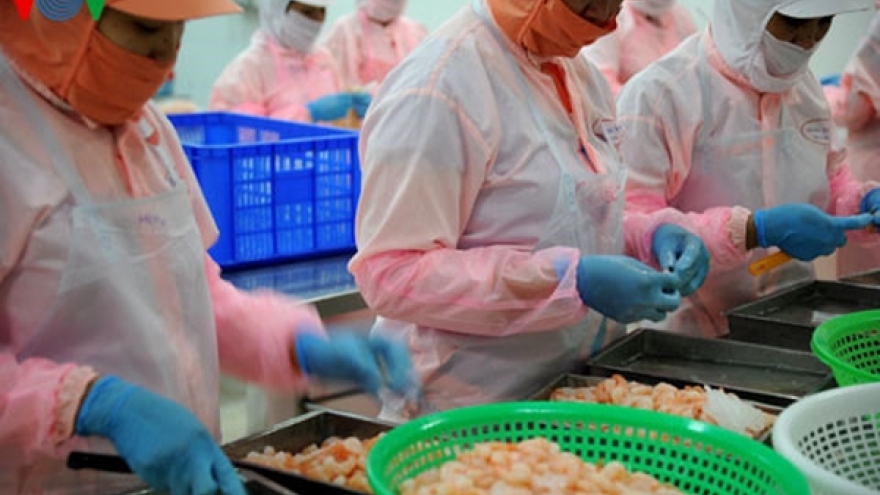Seafood exports to China set US$1.5 billion target for 2019
VOV.VN -China is one of four markets where Vietnamese seafood products hit more than US$1 billion per year in import value and is considered one of the most important consumption markets for the country’s seafood products.
 |
According to the Vietnam Association of Seafood Exporters and Producers (VASEP), during the first four months of the year, the export value of seafood products decreased by 1.3 per cent to US$2.428 billion against the same period last year.
Of the most lucrative markets for domestic seafood products, Japan remains top with a turnover of US$411.85 million, up 9.3 per cent over the same period last year, trailed by the EU at over US$393 million, the US at US$385.86 million, and China at US$324.54 million.
According to the World Trade Organization, Vietnam is among the top 10 nations in exports of seafood products to the Chinese market and accounts for 3 per cent of seafood exports to the market.
Statistics released by the General Department of Vietnam Customs shows that the country’s aquatic exports to China reached between US$1.2 billion to US$1.3 billion last year, ranking third as the supply source for the Chinese market. Key seafood export products to the market are largely made up of shrimp and tra fish, also known as pangasius.
After experiencing a sharp increase of nearly 50 per cent in seafood export value during 2017 with nearly US$1.3 billion, seafood exports to the market dropped by 5 per cent to only US$1.2 billion in 2018 and fell a further 5 per cent to US$239 million in the year’s first quarter.
This decline is attributable to the fact that China has tightened border trade whilst domestic products have to compete with India and Ecuador in the shrimp market.
Furthermore, the escalating US-China trade war has also created fluctuations in the market and caused the Chinese yuan to depreciate in value.
Although seafood exports have seen a decline, several major Chinese localities are keen to expand trading activities with the country rather than purchasing seafood products through intermediaries.
E-commerce has provided a way for Vietnamese seafood products to be introduced to the Chinese market and has been effective in making a strong presence there.
A potential market for Vietnamese tra fish
China enjoys the benefits of a low-cost workforce with aquatic product manufacturers specialising in processing fish to sell to other nations. However, this trend is changing with many major Chinese cities seeing strong growth in the sales of tra fish fillet products through online commercial channels.
Truong Dinh Hoe, VASEP Secretary General, highlighted tra fish as an ideal product for Chinese people. Previously, Vietnam only exported tra fish to a few localities in border regions. Recently this trade has been growing with tra fish products enjoying a presence in metropolises such as Beijing, Shanghai, and Dailian with demand only set to increase in the future.
Although the Chinese market has opened up a wealth of opportunities for domestic exporters, it also poses a number of potential risks with the Asian giant recently tightening food safety and hygiene standards as well as implementing tougher regulations on the trade of seafood products through the unofficial channels.
According to Rabobank, China has kept pace with the EU as the world’s largest importer of seafood with nearly 5 million tons of seafood imported in 2018.
Tra fish remains the best option for consumers seeking white-meat fish, said Mr Hoe, noting that businesses must overcome challenges by first winning the trust of Chinese consumers who purchase fillet products instead of fresh tra fish.
According to the World Bank, China’s average GDP per capita increased from US$3,471 in 2008 to US$8,827 in 2017.
During the same period, Vietnam’s average GDP per capita rose from US$1,143 to US$2,342. These figures reveal that the country’s labour costs are now far cheaper than that of China, whilst tra fish businesses in the Mekong Delta region are selling fish at more competitive prices to the Chinese market.
2019 will present good opportunities for seafood businesses to expand their exports through maritime routes to major cities if their products are able to meet criteria in terms of food safety and quality set forth by Chinese importers.
With the development of e-commerce, aquatic products are creating a presence on Chinese websites, providing a chance for domestic seafood businesses.
In order to secure a firm foothold in the vast market with a population of 1.4 billion people, businesses must ensure that they meet requirements on product quality. Moreover, relevant agencies should tighten their controls on cross border export activities to create fair competition among businesses and enhance competitiveness of Vietnamese seafood products, Hoe noted.


